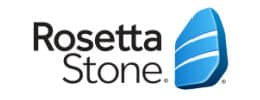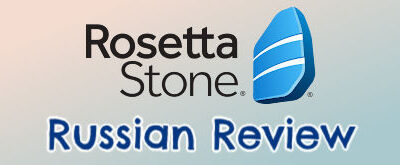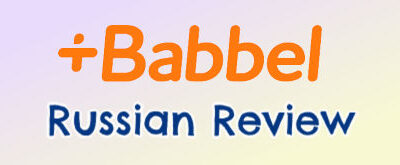Rosetta Stone’s Japanese language program offers an immersive approach designed to engage learners through a blend of interactive lessons and visual cues. By leveraging its renowned immersion method, Rosetta Stone aims to build a strong foundation in Japanese vocabulary and grammar while making the learning process enjoyable. This review explores the effectiveness of the program, highlighting its unique features and assessing its suitability for different types of learners.
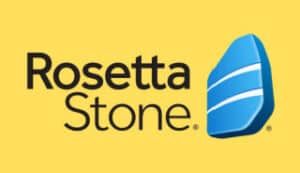
Rosetta Stone
- Multiple Subscription Options
- Money Back Guarantee
Pros
- Affordably priced subscription plans ($10-$15/mo)
- Ideal Japanese course for visual learners
- Immersive learning method that engulfs you in the language
- Accurate speech recognition technology
- Helpful bonus resources and learning tools
Cons
- Lesson format can become boring at times
- Not ideal for auditory learners
How Rosetta Stone Teaches You Japanese
Let’s delve into how the Rosetta Stone Japanese program stands out from its counterparts. Unlike other Rosetta Stone courses, which typically feature 20 learning units, the Japanese program has a more condensed structure with just 12 units, each consisting of 4 lessons—totaling 48 lessons.

This streamlined format, while shorter, is packed with in-depth content, with each lesson designed to take an hour or more to complete.
A notable update in recent years is the division of the core 30-minute exercise into three 10-minute segments, making daily study more manageable. Rosetta Stone’s approach emphasizes imagery over text, with exercises involving matching spoken Japanese to pictures, identifying Kanji and Kana, and describing images verbally.
This immersion-based method encourages forming natural connections between words and images, though learning Japanese presents additional challenges due to its use of Kanji and Kana rather than phonetic scripts.
Rosetta Stone Japanese Cost
Rosetta Stone offers three subscription options: 3-month plan at $16 per month; 12-month plan at $14 per month; or a lifetime plan for $400. By the way, the lifetime plan includes unlimited access to all Rosetta Stone languages, not just Japanese (in case you want to learn French, Italian, or German as well).
Also, the company frequently runs promotions, allowing you to snag the monthly plans for as little as $10 to $12 per month. Similarly, the lifetime plan, normally priced at $400, is often discounted down to around $150-200.
In comparison to other Japanese language learning apps, Rosetta Stone’s pricing is moderate. It falls between the less expensive options like Duolingo and Busuu and the pricier alternatives such as Pimsleur and Rocket Japanese. Overall, with potential discounts, Rosetta Stone provides a solid value.
Pros Explained
Now that you have a better feel for cost and how the Rosetta Stone program works, let’s discuss the major reasons why you should consider signing up to learn Japanese.
Immersive Learning Experience
One feature of the Rosetta Stone Japanese program that our team finds intriguing, though it may not suit everyone, is its immersive learning method. The program dives you straight into Japanese, minimizing the use of English.
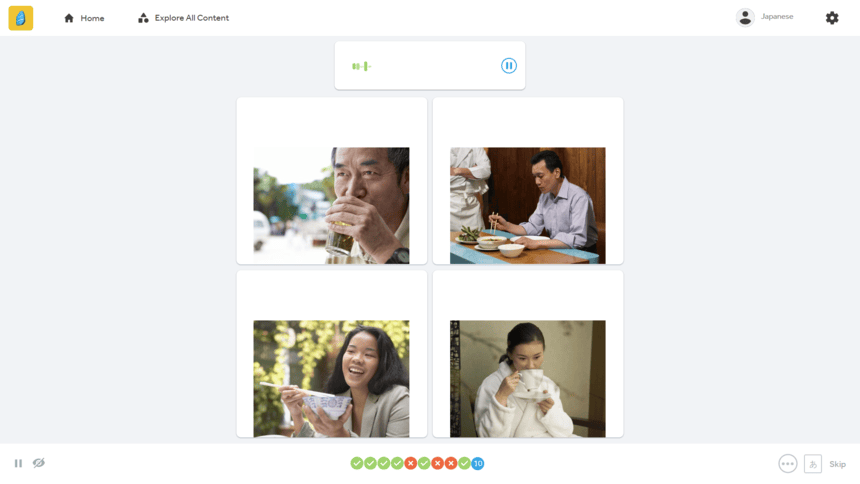
For instance, phrases and sentences aren’t provided with English translations, and instructions are largely given in Japanese. While there is an option to enable translations, Rosetta Stone generally encourages learners to avoid this to fully immerse themselves and grasp the language intuitively.
This approach can be initially challenging, as it removes English as a reference point, but it effectively enhances listening and speaking skills by teaching you to understand Japanese directly. Although reading and writing may be more difficult, this immersion strategy can be quite effective for verbal communication.
Visually Appealing Lessons
Another standout feature of the Rosetta Stone program is its extensive use of images and visuals throughout the lessons. For those who learn best visually, this approach can be particularly effective. Research suggests that around 50% of people are visual learners, meaning they retain information better when they can see it. Rosetta Stone’s picture-rich lessons cater to this learning style exceptionally well.
While I personally prefer audio-based learning and appreciate programs like Rocket Languages that excel in this area, Rosetta Stone offers a distinct advantage for visual learners with its strong emphasis on imagery.
Helpful Speech Software
Another notable feature of Rosetta Stone is its TruAccent speech recognition technology, which is incorporated into nearly every lesson. This tool provides instant feedback on your spoken practice, helping you refine and perfect your Japanese pronunciation. In our view, TruAccent is a standout component of the Rosetta Stone Japanese program and ranks among the top speech recognition tools available in language learning, alongside Rocket Japanese.
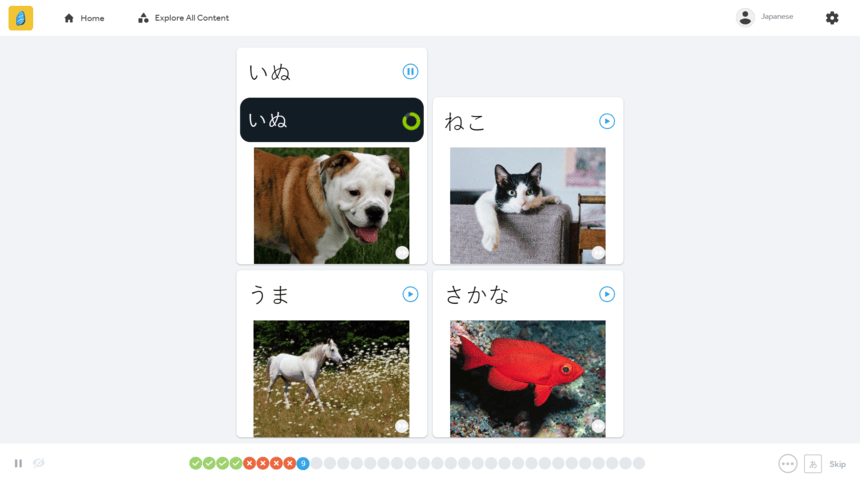
The TruAccent technology is user-friendly, accurate, and effective, making it a valuable asset for improving verbal skills. Since speaking aloud is crucial for effective language acquisition, Rosetta Stone deserves commendation for its strong emphasis on speech practice.
Bonus Learning Tools
Lastly, it’s Rosetta Stone’s array of additional resources that set it apart from other language apps. The program offers a range of valuable supplementary tools, making it one of the most thorough Japanese learning platforms available. While other apps also provide extra features, Rosetta Stone’s offerings are notably more extensive.

Among the various extras, our team finds the stories feature especially appealing. These are essentially short audio segments with accompanying transcripts that become accessible as you progress through the learning units.
The short stories not only enhance your comprehension but also provide practical context for the language you’re learning, making it easier to understand how words and phrases are used in real-life situations. Additionally, they help improve listening skills and vocabulary retention by exposing you to diverse sentence structures and everyday conversational patterns.
Cons Explained
Now that we’ve touched on the positive aspects of the Rosetta Stone Japanese program, let’s turn the tables and discuss the negatives. That way, you have a fair, balanced view.
No Gamification
A notable area where Rosetta Stone could improve is by fostering a stronger sense of community among its users. Apps like Duolingo and Memrise have gained popularity in part due to their successful integration of competitive and collaborative elements, such as leagues, social connections, and joint challenges.
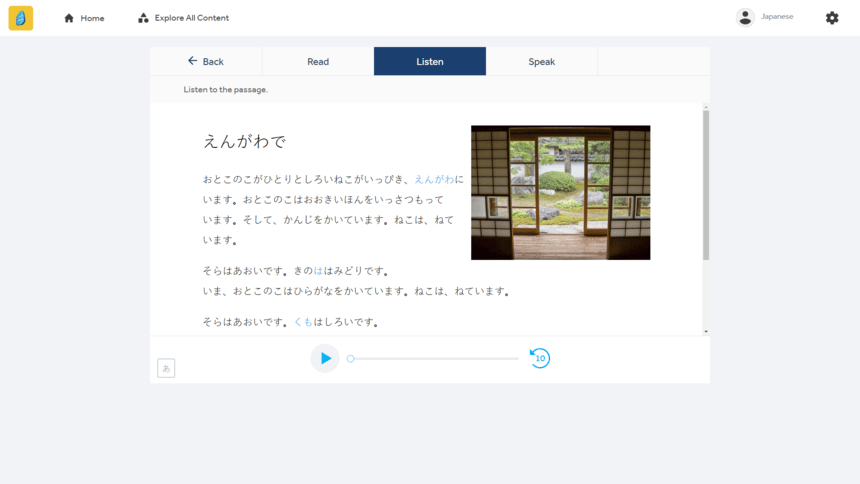
Incorporating features like a buddy system or user interaction could significantly boost engagement and motivation. By adding these community-driven aspects, Rosetta Stone could enhance the learning experience and encourage users to stay committed to their language goals.
Lesson Format Can Become Dull
Another drawback of this program is that the exercises can occasionally feel repetitive. Given that each drill relies heavily on images, the variations between them can start to blur. While it’s not as pronounced as with some other apps, Rosetta Stone’s lessons can sometimes lack the variety found in platforms like Duolingo or even Pimsleur.
Lack Of Direct Grammar Instruction
The last drawback of the Rosetta Stone program is its lack of explicit grammar instruction, which can be particularly challenging with a language like Japanese that has different grammatical structures from English.
The program focuses on teaching grammar through an immersive, intuitive approach rather than providing clear, direct explanations in English. While this method has its merits, we find it less effective compared to more straightforward grammar explanations followed by practice exercises, as it can sometimes lead to frustration.
Verdict: Is Rosetta Stone Good For Learning Japanese?
Generally, the answer is yes, particularly if you are a visual learner. The program’s emphasis on visual elements and immersive learning makes it highly effective for those who learn best through images and hands-on activities.
However, if you prefer auditory learning and are seeking traditional audio-based lessons, Rosetta Stone might not be the ideal choice. Alternatives like Rocket Japanese or Pimsleur Japanese could be better suited for your needs. While Rosetta Stone does include some audio features and stories, its primary focus is on visual and immersive methods.
Overall, Rosetta Stone is a solid choice for visual learners who appreciate an immersive, interactive approach to language acquisition.
👉 Read Next: Best Apps To Learn Japanese
The monthly subscription for Rosetta Stone Japanese typically ranges from $10 to $12 after applying various discounts and promotional offers. Alternatively, a lifetime membership is available for approximately $400, though it frequently goes on sale for around $200.
Yes, our team finds that the Rosetta Stone program is effective for learning Japanese, particularly for those who are visual learners rather than auditory learners. The program’s focus on immersive, picture-based exercises aligns well with visual learning preferences, providing a robust learning experience. However, it may be less suitable for those who thrive on auditory methods and prefer traditional audio-based instruction.

